Master and Dynamic MW60 Review – Industrial Revolution

Pros –
Bulletproof build, Fashionable industrial design, Full yet well-controlled sound
Cons –
Bass may be overwhelming for some, Thin headband produces some comfort issues, Premium pricing
Verdict –
With the MW60, Master & Dynamic successfully provide a similar, if not superior experience to their wired model with the added liberation of a stable wireless implementation.
Introduction –
Master and Dynamic are a US-based audio manufacturer that pride themselves on their flawless industrial designs and well-realised tuning. Shortly following the success of their portable over-ear MH40, they promptly released the MW60, its wireless, closed-back counterpart. Alongside wireless connectivity, the MW60 brings a completely redesigned chassis that is more suitable for portable use, but also one that carries the same rigidity and flawless level of finish.
Furthermore, though it uses the same drivers as the MH40, the MW60 sounds different due to a well-considered retune in addition to differing acoustics between their respective semi-open and closed-back designs. At $550 USD, the MW60 does represent a sizable price jump from the already premium MH40, though its exceptionally premium construction and lush sound will surely win buyers over. You can read all about the MW60 here.
Disclaimer –
I would like to thank Andrew from Master & Dynamic very much for his quick communication and for providing me with the MW60 for the purpose of review. All words are my own and there is no monetary incentive for a positive review. Despite receiving the headphones free of cost, I will attempt to be as objective as possible in my evaluation.
Accessories –
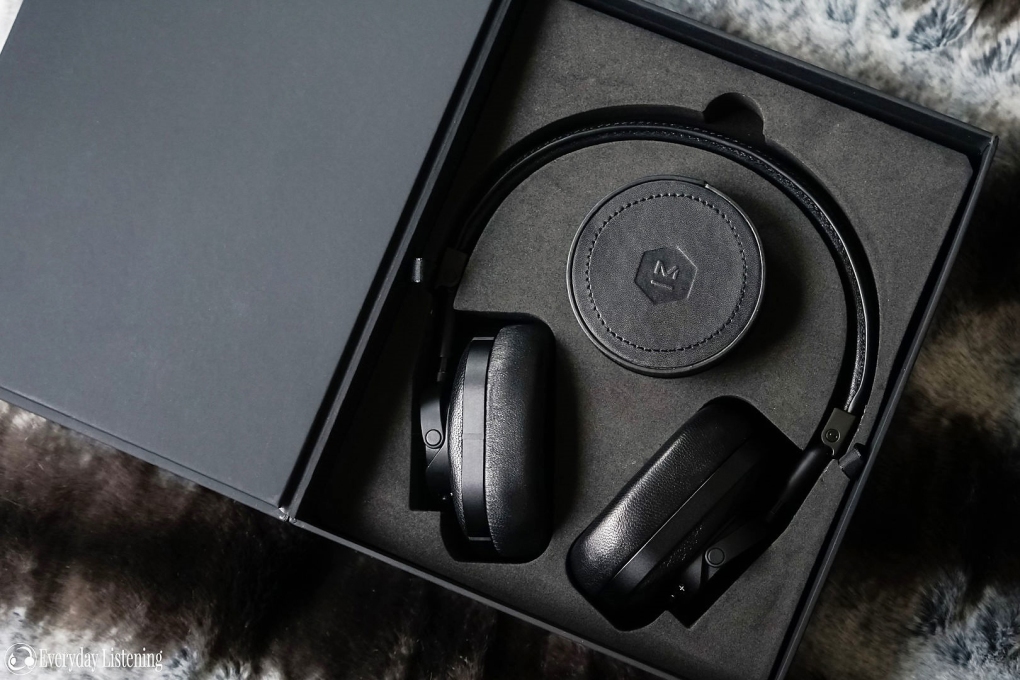
The MW60 is packaged much like the MH40, presenting very professionally. Upon opening the box, buyers are greeted by a quick start guide, leather accessory box and the headphones themselves.
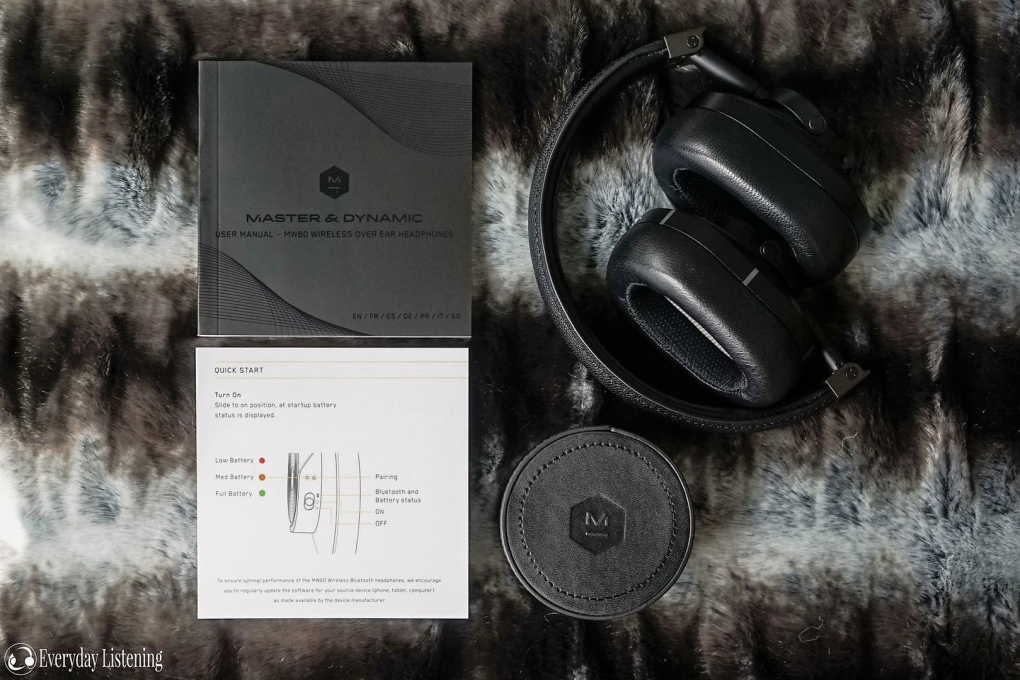
The leather box contains a 1.25m audio cable should you want to run the headphones from a wired source in addition to a micro-usb charging cable and ¼” adapter. Underneath are the manuals, a small canvas cable pouch and larger zippered case.
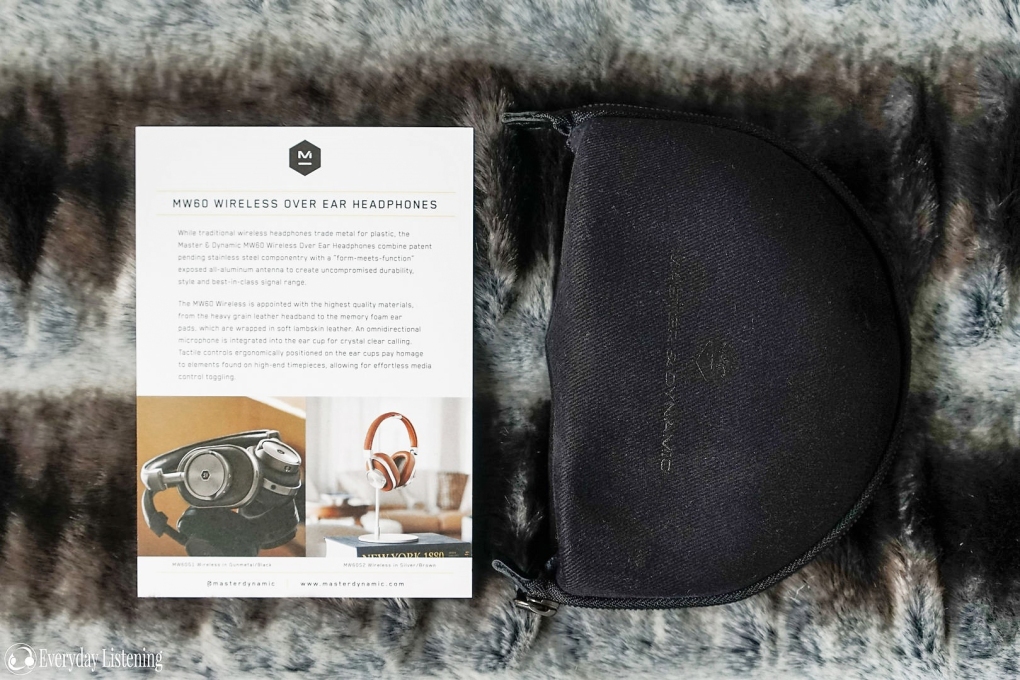
Though the case presents well and is impressively compact, the earpads do become indented when the headphones are stored within it. The headphones also no longer fold flat.
Design –
Master & Dynamic have achieved universal notoriety for their expertise in design and manufacturing. Unsurprisingly, the MW60 maintains this tradition as a headphone that feels exceptionally sturdy while managing to be just as visually captivates as prior models. Though fashion cans may carry negative connotations in the scrutinising world of audio, the MW60 executes stylish design through premium materials, precise finish and eminent engineering.

Utilising similar innards, the MW60 very much resembles the MH40 in dimension and ergonomics. It shares the same class-leading stainless steel frame and combination of hard-wearing cowhide leather on its exterior faces and ultra-supple lambskin leather on the pads and headband. Resultantly, the headphones feel as solid as they come, a triumph in industrial design. This impression is garnished with tight tolerances and quality control; clips engage with an affirming thud, hinges swivel with fluidity and M&D’s machining work is nothing short of jaw-dropping.
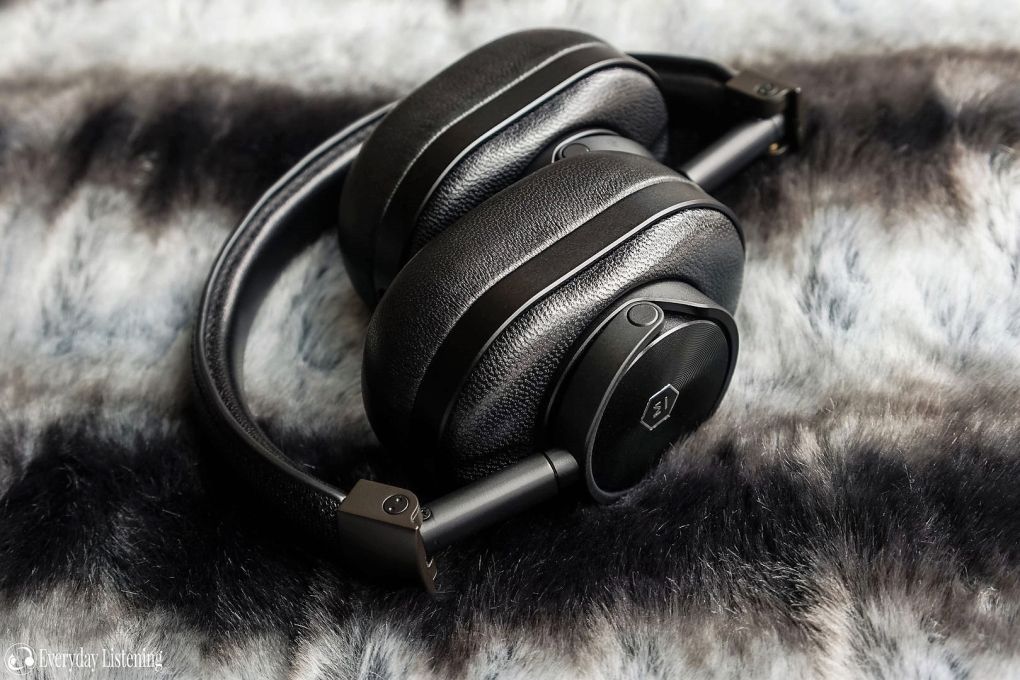
During wear, the MW60 suffers from the same ergonomic niggles as the MH40, even though it’s actually a little lighter at 345g vs 360g. Chiefly, though nicely padded, its thin headband and heavy steel construction tend to form a hotspot after just a few hours of listening. And as with the MH40, I found the MW60 to have quite a narrow range of headband adjustment. I still found a strong seal and the sliders are smooth with unlimited adjustment points, though I just fit the maximum setting (I use a medium setting on most headphones). In return, the headphones fold for storage, becoming considerably more compact.

And on the flipside, I’m just as fond of M&D’s lambskin memory foam ear pads that are deep and spacious. They create a strong seal and have a fabric interior that breathes a little more during longer listening sessions. Due to the MW60’s closed-back design, they also isolate brilliantly, appreciably better than the MH40 before and most other portable headphones I’ve used. Some driver flex is present but it isn’t nearly as pronounced as on the MH40.
Usability –
The MW60 functions similarly to most Bluetooth headphones. They will be familiar to past owners and easy to navigate for new users. The main controls are located on the bottoms of each earcup, a 3-position sliding switch operating power and paring on the left cup and media controls on the right cup. Holding the power button enters pairing mode and as the MW60 support Bluetooth V4.1, it can pair with two devices simultaneously. The headphones also support Apt-X which brings higher quality audio when paired with a compatible device – and most modern smartphones are.

Master and Dynamic are also quick to note the external aluminium antenna sveltely integrated into the frame of the headphones that promises 4x the range of conventional wireless implementations. Though connection was rock solid over my months of testing, the MW60 didn’t provide extraordinary range. Signal is still more stable than the vast majority of headphones, without a single cutout when listening in crowded environments with rampant interference. That said, a few headphones such as the V-Moda Crossfade 2 Wireless hold stable audio a little longer at their periphery.

The MW60 retaliates with impressive battery life that fell just short of Master and Dynamic’s 16hr claim on low-medium volume. Still, it’s a very respectable figure in-between the 20hrs offered by models such as the Bose QC35 and the shorter 14hrs provided by V-Moda’s Crossfade 2 Wireless. Of note, the left earcup has two LED indicators, one for connection and power status, the other for power. The headphones also produce loud audio cues to denote status that I found to be a little intrusive. That said, in listening, the headphones have zero background noise enabling listeners to focus more on their music.
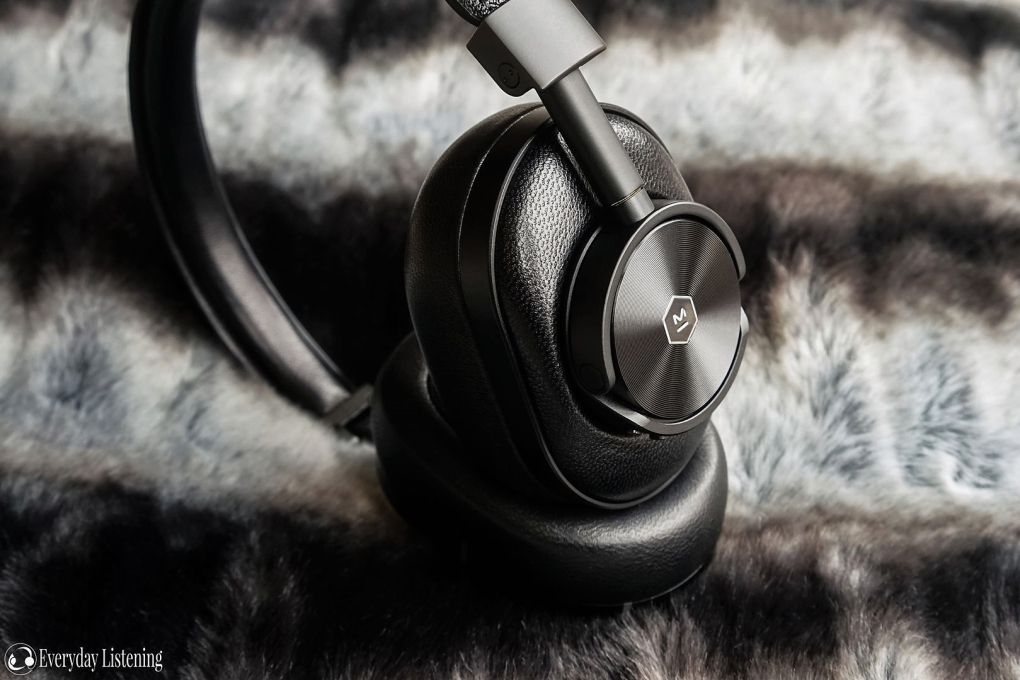
The headphones charge via a micro-usb port on the right ear cup and can be run from a wired source using the 3.5mm port on its left ear cup. Thankfully, the headphones don’t require power to relay audio and they do scale nicely when powered by a dedicated source (more in the sound section). When powered on, they automatically turn-off when a 3.5mm cable is inserted and power back on when the cable is removed.
Sound –
Tonality –
The MW60 is a warm headphone with a full character that sustains throughout its presentation. However, it doesn’t sound as warm through its midrange as a lot of portable headphones, delivering more accurately articulated vocals. Compared to the MH40 that utilises the same drivers, the MW60 delivers a similar sound, but one that is slightly more engaging up top and with a more concise impact down low. Though it doesn’t represent a huge leap in quality, it’s easy to appreciate the little tweaks here and there that provide a more even sound overall.
Bass –
The MW60 stays true to Master and Dynamic’s house sound, with a big, bold yet not overly warm low-end. It extends very well, with solid emphasis delivering physical impact and rumble. Bass drums have awesome kick and beats hit with authority; all the while maintaining impressive composure. Mid-bass holds slight focus, though as the MW60 doesn’t sound especially humped in its emphasis, notes are large without becoming overly rounded. This style of tuning produces a fuller, warmer character that will delight speaker users and fans of genres such as electronic and rock, but may be somewhat overenthusiastic for those seeking balance. The MW60’s mid-bass feeds gradually into a less emphasized, but still lifted upper-bass that colours its midrange.
As a result, this isn’t the cleanest, most transparent headphone, instead prioritising lush body and engagement. Furthermore, the MW60’s strong but even-weighted bass presentation is realised through impressive technical ability. This isn’t immediately evident as the MW60’s large bass notes can overshadow finer details, though behind its bombastic façade lies a tight and well-controlled image; a trait maintained from the MH40. It also isn’t the most agile headphones nor the most separated but notes are concise and rumble well-defined; there’s a sense of restraint to every note, reeling them in before they spill over the next. Accordingly, the MW60 doesn’t gun for accuracy but for a charismatic presentation augmented with impressive control.
Mids –
Though coloured by its neighbouring frequencies, and recessed relative to its elevated bass, the MW60’s midrange is itself fairly even. It thereby achieves a nicely layered presentation that has one of the more natural tones amongst portable headphones. The MW60 still lies on the warmer side, delivering a rather full-bodied presentation. This is mainly a by-product of an emphasized upper-bass/lower-midrange, though as its tuning is quite linear, voicing remains very natural. Its centre midrange is fairly neutral, which produces slightly laid-back vocals relative to its accentuated instrumentation. That said, this prevents vocals from coming across as overly thick and congested; male vocals are just chestier at the bottom and female vocals organic.

The MW60 also has a slightly brighter signature with a small but gradual upper-midrange and lower-treble emphasis. This aids articulation, creating a surprisingly clear and open midrange despite its fuller, warmer nature. As such, the MW60 is also clearer and more articulate than the smoother MH40, arguably improving genre versatility. Resolution is pleasing if not a standout and its notes are fairly well textured on account of the MW60’s well-bodied notes. Though I wouldn’t say it has a focus on accuracy, timbre is also pleasing, with the headphones skilfully avoiding over-articulation and, on the other side of the spectrum, congestion.
Highs –
Though treble crispness and air can provide a superficially stunning sound, the more refined approach taken by the MW60 ensures continued enjoyment over long-term ownership. Compared to the smoother MH40, the MW60 possesses a more vibrant presentation on behalf of its greater lower-treble elevation. It’s a narrow band emphasis that does compromise linearity when compared to the MH40, though it also grants a clearer, crisper and more open presentation. And, in the grand scheme of things, the MW60 can hardly be categorized as a bright, aggressive headphone. Rather, it has a tasteful bump that enhances instrumentation with a little more edge and clarity. Middle treble is also slightly lifted, granting a touch of additional air and shimmer.
It also serves to counteract the effects of the MW60’s otherwise thicker style of tuning by enhancing separation. Extension isn’t outstanding, but superior to most midrange portable headphones and easily adequate to offer a nice amount of resolution and hints of sparkle. Accordingly, the MW60 doesn’t excel with air nor is it especially revealing in its presentation. Rather, it’s a headphone with a nicely detailed foreground and dark, clean background. It’s slightly elevated lower-treble attack grants a crisp portrayal of instruments and sustained emphasis into middle treble promotes more accurate decay. The headphones sound crisp but natural as a result, retaining the endless listenability of their wired counterpart.
Driveability –
The MW60 is very similar to the MH40 with the same 32ohm impedance and 106dB sensitivity. As such, they’re fairly efficient and will achieve high-listening volumes from portable sources. That said, much like the MH40, the MW60 scales nicely from a dedicated source. They definitely benefit from a decent amplifier, most notably with regards to bass which tightens up, improving transparency throughout. Subjectively, I also feel that the MW60 has one of the better wireless audio implementations out there with essentially zero background hiss and impressive driving power. To clarify, I’m not just referring to the maximum volume achieved by the MW60 over a wireless connection, but also its well-controlled sound that is comparable to a wired connection to a better smartphone such as the HTC 10.
Wired –
Given Master & Dynamic’s focus on sound quality, this review wouldn’t be fair if I didn’t offer comments on the MW60’s sound from a quality wired connection. Driven from my iBasso DX200 with AMP5 module, I noticed several key changes compared to wireless (Apt-X). The most notable difference was the MW60’s high-frequency response. I would also posit greater linearity throughout their entire spectrum, perhaps on account of some subtle DSP when BT is active (though that I cannot confirm). Regardless, they were noticeably more detailed through a wired connection; still crisp, but with greater instrument body and texture. Treble extension improved as did their soundstage, with higher resolution enhancing layering, especially within their midrange. Vocals sounded more realistic with a hair of additional vocal presence creating greater balance. Bass was noticeably more controlled, yielding greater definition and separation. Though the differences aren’t immense, they are very easily appreciated, especially the bump in resolution.
Comparisons –

Master & Dynamic MH40 ($400): The MH40 is a mellower headphone with more laid-back vocals and a less energetic treble response. The MW60 is more evenly weighted between sub and mid-bass while the MH40 is a touch more mid-bass focussed with less sub-bass impact. Both headphones are full through their upper-bass/lower-midrange transition though the MH40 has a slightly more laid-back centre midrange. As a result, the MH40 has slightly more distant vocals than the MW60 though both are very natural in their presentation. The MH40 has a noticeably smoother lower-treble that makes its middle treble elevation more pronounced by comparison. As such, the MH40 is more relaxed, and it isn’t quite as clear through its midrange due to its comparatively subdued articulation.
Above, however, both have similar extension and middle-treble quantity is even between the two; the MW60 just has a little more lower-treble. This makes it slightly crisper, though as it’s less linear and some finer nuances are lost when compared to the MH40. Still, the MW60 is clearer and more vibrant, it demonstrates greater engagement without sacrificing much listenability or compromising timbre. The soundstage was a highlight on the semi-open MH40, a quality heightened by its laid-back midrange and high-end that emphasized its sense of scale. As the MW60 is closed, it doesn’t expand quite as naturally as the MW40, but it’s more articulate tuning results in a presentation that remains spacious and is a little more separated.
Meze 99 Neo ($250): The Meze 99 neo is tuned similarly but has a slightly darker midrange and brighter lower-treble. The result is a headphone with a greater V, though both can be characterised as natural and warm sounding headphones. The MW60 flaunts slightly greater sub-bass extension and impact than the 99 Neo. The Meze has a similarly emphasized mid-bass response, though it sounds more rounded on account of its less emphasized sub-bass. The 99 Neo also isn’t quite as controlled, sounding a little looser and less defined than the MW60. The Meze has a more laid-back midrange than the MW60, it’s not as clear and has a warmer tone. The 99 Neo has quite a thick midrange as a result, not congested, but more full-bodied than the MW60.
Though the MW60 isn’t as linear, its vocals have greater clarity on account of a slight upper-midrange lift. Both have relatively elevated lower-treble, the MW60 is crisper and a little more aggressive while the 99 Neo is more organic in its treble presentation. That said, the MW60 extends further and has a more neutral middle-treble where the Meze is slightly attenuated. As a result, it has noticeably greater air and more textured instrumentation, but as its lower-treble is a little peakier than the 99 Neo, its foreground is slightly less detailed. The Meze 99 Neo has a larger soundstage on account of its more laid-back midrange though it’s also less separated. Both have similar imaging properties, well-placed but not pinpoint accurate with the advantage going to the M&D headphone.
V-Moda Crossfade 2 Wireless ($330): V-Moda are renowned for their bassy headphones yet the Crossfade 2 doesn’t stand out as an explicitly bassy headphone when compared to the MW60. Chiefly, the Crossfade 2 has similarly strong sub-bass extension combined with greater emphasis. As a result, it’s more physical though it also isn’t as tight. Mid and upper-bass are attenuated by comparison, with the MW60 delivering a fuller but also more bloated sound. That said, as the MW60 has greater control, it is just as defined if not more so. The nature of their bass tuning influences the tone of their midrange, with the Crossfade 2 Wireless sounding cleaner and brighter and the MW60 sounding fuller and smoother.
The MW60 is undoubtedly the more natural sounding headphone. The Crossfade 2 has greater clarity and separation, but it’s also slightly thin with over-articulated vocals. This also stems from their treble tuning. Where the MW60 has a small lower-treble bump, the Crossfade 2 combines a modest lower-treble accent with a reasonably large middle-treble emphasis. The result is a much more open, airy sound, but also one with a bright background and some glare. The more linear MW60 retrieves greater detail as a result. Both have large soundstages for closed-back headphones, the Crossfade 2 Wireless is more separated while the MW60 has more accurate instrument placement.
Denon MM-400 ($400): The MM-400 is a very underrated portable headphone and one of my personal favourites. It’s the more balanced headphone with a little extra clarity up top. The MM-400 also has less bass quantity than the MW60; it lacks the same sub-bass reach and impact but is more linear, less bloated and a fair bit cleaner in its low-frequency presentation. Still, the MW60 has similar definition though its larger notes don’t make this as apparent. The MW60 has a thicker midrange, mainly on behalf of its greater upper-bass emphasis. The MM-400 sounds cleaner and more transparent though it’s still on the warmer side. The Denon is also more articulate with greater clarity and layering at the cost of a slight lack of density.
The MM-400 has a slightly more present upper-midrange that feeds into a more emphasized lower-treble, granting it a more aggressive detail presentation. However, as the Denon is more linear between its upper midrange/lower treble transitions than the MW60, it’s more detailed in addition to being more upfront in its presentation of those details. That said, despite being darker, the MW60 extends further than the MM-400, so though it has less clarity, the MW60 delivers greater resolution. The MW60 also produces a larger stage with greater width though the Denon has a touch more depth. The Denon’s greater balance makes it the clearly more separated headphone and instrument placement is more precise on top.
Verdict –
It would’ve been easy to take the MH40, add Bluetooth, bump up the price and call it a day. But what the MW60 represents instead, are many subtle upgrades over its wired sibling that culminate to produce a considerably more convenient and engaging experience. This includes retuned drivers, the thoughtful addition of folding hinges and a more isolating closed-back design that all better optimize the MW60 for portable use. Combined with its reliable wireless connectivity and strong battery life, the MW60 is a terrific premium headphone for jack-less smartphone users searching for a robust yet fashionable headphone.

As it retains the bullet-proof solidity of the MH40, the MW60 makes for a similarly great daily-driver though it also wears on the head during longer listening sessions as a result. That said, in a quiet environment, their sound doesn’t fatigue while providing crisp instrumentation, well-articulated vocals and a powerful yet nicely controlled low-end. Of course, they were never intended for extended home usage – and, at $550, home users will definitely want to investigate the wealth of sonically superior open-back competitors. However, for their intended uses, the MW60 excels; and few wireless headphones are so distinguished in every regard.
The MW60 can be purchased from Master & Dynamic. I am not affiliated with Master & Dynamic and receive no earnings from purchases through this link.


One thought on “Master and Dynamic MW60 Review – Industrial Revolution” Leave a comment ›